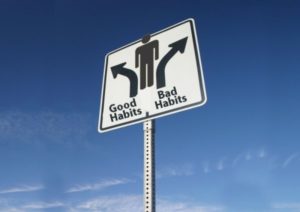In this issue:
Editor’s Corner. New Year’s resolutions in reverse. Habits for humanity. Electronics and sleep. Make that New Year’s habit stick! Need a gym? Try your local Senior Center! Do you see this red color? Improve your squats and deadlifts.

Before you reach for those chips, ask yourself: is that really hunger you’re feeling? Photo by Mustafa Bashari on Unsplash
HELP SPREAD THE NEWS! Our next issue will be on Wednesday February 16th. In the meantime please tell all your colleagues and friends about FitITproNews and its companion newsletter WServerNews, and let them know that they can subscribe to these and other TechGenix newsletters for free here. And if you have any questions or comments about anything in this month’s issue of FitITproNews, feel free to email us! Thanks!!
Editor’s Corner

Mitch Tulloch is the Senior Editor of FitITproNews and a recovering fat IT pro who lost 50 lbs in midlife and is now on his way to becoming a fit IT pro. Mitch is a widely recognized expert on Windows Server and cloud technologies who has authored or been Series Editor of numerous books/ebooks from Microsoft Press. Mitch is also the Senior Editor of WServerNews and writes frequently for TechGenix.
Hey everyone! Welcome to the January 2022 issue of FitITproNews, the world’s only newsletter devoted to helping “recovering fat IT pros” make progress on the journey towards strength and health!
You probably noticed the photo and caption at the top of this month’s newsletter. And I’ll bet it made you hungry looking at it 🙂
But before you reach for that bag of potato chips ask yourself, Am I really hungry or is this some other feeling I’m experiencing? Could it instead be:
- Tiredness from not enough sleep?
- Stress over a situation in your work or life?
- Lack of energy due to too much physical inactivity?
- Fuzzy-mindedness because you drank too much wine yesterday evening?
The answer to each of these problems is not to grab something fast to eat like potato chips. The solution is to figure out first which feeling you’re experiencing and then act appropriately to address it.
For example, if you’re feeling tired because you didn’t sleep enough, take a 5 or 10 minute break and sit in a soft chair in a quiet room and think about nothing. Or if you’re feeling stressed because of some situation in your work or life, take a coffee break and analyze what’s caused that situation and come up with some practical steps you can take to resolve the situation, then plan and schedule how and when you will take those steps.
One could call this kind of thing being mindful, but IMO mindfulness is an overused concept these days. So let’s invent a new term for doing this—let’s call it soul awareness.
Maybe I should start a Soul Awareness Movement and become its guru?
Anyways, on to this month’s newsletter…
What’s inside this issue of FitITproNews
We have lots of great articles from our columnists this month which I’m sure you’ll enjoy and can learn from.
Lana Khazari describes how it’s typical that we make New Year’s resolutions to change something about ourselves and why this often fails. Kris Lall talks about the challenges of breaking old habits and stablishing new ones. Sarah Trammell deals with a problem us techies often experience: poor sleep because to using electronic gear around bedtime. Kris Kane explains how we can make those New Year’s fitness resolutions stick. Judith Shipps recommends checking out your local Senior Center if you’re over 50 and want a gym to work out at. Andrey Sarantsev talks about the critical importance of warming up before you do any strenuous workout of sport. And finally Robin Camp shares four simple tips how you can improve your squats and deadlifts.
Enjoy this month’s issue of FitITproNews and feel free to send us feedback on any of the topics we’ve covered — we love hearing from our readers!
Cheers!
Mitch Tulloch, Senior Editor
New Year’s resolutions in reverse (Lana Khazari)

Lana Khazari is a Technical Support Analyst for the Corporation of City of Windsor, Ontario, Canada. She is also a Precision Nutrition Coach, Personal Trainer, Fitness Instructor and a Yoga 200-RYT Instructor. You can find her online at lanakharazi.com.
Have you already given up on the exact old resolution for the 30th time? If you feel anything like me, it was way too hard to even think about resolving to change something at the onset of this year. With the pandemic entering its third year, the mental bandwidth didn’t allow me to do much more than what I’m already doing.
Then, on January 5th, Ontario, Canada, is in lockdown, again, for the fourth time. The response is ugly because and we are all worn out. I’ve seen a couple of good friends who have lost jobs to vaccine mandates, other friends burnt out from online teaching, and the chaos of kids’ virtual schooling. And while I feel fortunate to not have any of those things happen to me personally, its effects still bring on anxiety and worry. I’m a full-time working mom who has a 3-year-old in daycare which has been sick more than not this past year. The swab got stuck up that toddler’s nose more times than needed, and thankfully, it came down to re-occurring ear infections and a possible ear tube surgery, but the situation is under control.
So now, I’m working from home, alone, with fewer people around me and moving less overall. Gyms, indoor dining, theatres, etc., are closed. Less commute buys more time, and the first thing that pops in my head is to resolve to do more workouts. Fortunately, now I have a pretty stacked home gym. I also just added a high-end spin bike to the mix and on week 2 of my Peleton app trial. As I do my strength training in the basement, I catch a glimpse of myself in the mirror, and those holiday pounds stare back. Immediately, I resolve to tighten up the diet and feel the pressure of needing to “fix” myself.
My Yin yoga training tells me to dig deeper into this pressure and need to “fix”. I start to analyze my resolves from both yin and yang perspectives.
It’s typical to make resolutions that change something about yourself. You resolve to stop doing something or decide to do something you don’t. We’ve heard most before: lose weight, stop smoking, exercise more, read more, write more, the list goes on. We begin to tap into “yang” energies to change ourselves somehow, to take action. Yang means change, movement, passion, success, the “big” things in life. Yin indicates acceptance, allowance, stillness, presence, and enjoying the “smaller” everyday stuff. With too much yang energy, we have difficulty accepting things outside our control and struggle to feel content. We relate passivity to laziness and lack of motivation. With too much yin energy, we can be too passive and unprepared for opportunities when they are presented. However good our intention for change, to be balanced; it helps to honor both yin and yang energies.
In even harder to balance the yin and yang in today’s society. It’s about Its “yang” endorsed and about constant self-improvement and achievement. Many stigmas exist like you should not be lazy, weak-willed, unsuccessful, unintelligent, lack self-discipline, or have poor willpower. We must recognize that most of our thoughts mirror society norms, and advertisements/media play into our inadequacies. Often the message is that you are flawed and that “they” have the solution or product to “fix” it. So, we buy into the new job, clothes, body, relationship, etc., and we keep vowing to get better.
I’ve bought-in so many times. Notice how I wrote that I “should” work out more. It’s been pretty clear that people have been exercising less during the pandemic despite having more free time. Some even took a complete layoff from exercise. Instead, I’m expecting more of myself at home because of having extra free time. And I “should” on myself.
Should-ing on one’s self is rooted in guilt. It’s saying that we should be better than we are right now. We are not happy and need to be different or better. Combine societal pressures for achievement, add some critical self-talk, and no wonder why resolutions can fade out quickly.
Even so, over the years, we can continue to buy into the “newness” in hopes of a fix. And yet we can still feel some level of inadequacy. We can resolve to give up sweets or claim we are doing a dry January. But deliberately restricting usually leads to an unhappy you. Soon enough, your family and friends also vibe on your unhappiness. This doesn’t mean that resolutions should be lost altogether, but one must realize that each decision has consequences and why it’s good to visit the intention to your resolve. The question to ask yourself is, “Am I doing this because I want to and I’m better of for it?” or “Am I doing this because I think I should be doing it?”.
If you don’t feel healthier, happier, or better off for doing it, how about you try the opposite this year. If you find yourself living the yang life with more energy, passion, and drive, what if you were to simply accept and not try to change? Tapping into more yin energies, you can begin to balance acceptance and action, prioritize what is truly worth your time and energy and live a more balanced life.
I challenge you this year to choose something in your life that you will just allow be precisely as it is. Instead of action, find acceptance. This can be really hard for action-takers!
Try these as resolutions:
- “I resolve to accept myself….my body, my appearance, my limitations….”
- “I resolve to stay….with my job, my partner, my pet, my environment…..”
- “I resolve to allow without judgment…my thoughts, my feelings, my actions….”
Just let it be. Accept and not change something you always strive to fix.
For me, I am re-adjusting my expectations of doing extra workouts. Instead, I’ll stick to the same program I do at the gym, modified for home equipment. And if I do less, that’s ok too. I resolve to release the judgment and guilt about where I choose to spend this extra time. Still going to tighten up the diet, though.
Habits for humanity (Kris Lall)

Kris Lall works as a product manager in the tech industry for an enterprise software manufacturer. As a youngster, Kris was consumed with soccer before technology came along. Now he’s consumed with both. You can find him on Twitter at the not-too-surprising handle @krisoccer.
The New Year brings with it new hope and an expectation that we should improve ourselves or something in our lives. Hence, the infamous New Year’s resolution. Naturally it’s easy to form a less healthy habit, like consuming too much food, and more difficult to form a healthy habit, like working out every day.
Staying fit takes work, but it’s as much of a psychological matter as it is a physical one. We often have the time, resources, and ability; we just need the will. So what’s the psychology behind how habits are formed? Why do some people stay the course and others do not? Can we create an achievable resolution?
We usually form habits to be efficient or accomplish something via repeating behavior on a regular cadence. I’ve heard it said that performing a task for 21 days will make it a habit; however, it depends on a number of factors. In The Power of Habit, author Charles Duhigg describes the factors that produce habits as the “habit loop”. The loop includes a trigger, a habit behavior, and a reward.
An example is my hydration habit. I used to drink water only when I was thirsty. Then, years ago I recall several sources promoting the health benefits of staying hydrated – including reducing the chance of having to pass a kidney stone. This was enough motivation (trigger!) for me to work water into a daily hydration habit. Now I keep a cup by the sink to remind me to fill up a couple of times per day and staying hydrated is no longer an issue. Hydration has many benefits, but a tangible reward is that I’ve never had to pass a kidney stone!
Whether you’ve formed a good or bad habit, it can be insightful to analyze your existing habits to determine how you came to form them. Doing this type of analysis can give you some idea on a best approach to forming a good habit. There are many ways to establish a good habit. Writing down a goal or a picture (visual reward) of what you’re trying to achieve and posting it where you’ll regularly see it, like the bathroom mirror or fridge, will keep it top of mind. Also, sharing your goal with someone can help solidify your commitment to it.
Breaking a bad habit is never easy, so be sure you understand the trigger, the current reward, and what your reward will be once you break the bad habit. Is the new reward substantial enough for you to put in the effort to break it? Another approach could be to escape your normal routine by travelling somewhere for a change in perspective.
Now we’re ready to formulate a resolution and create a good, beneficial habit. As an knowledge worker who spends most of my day sitting, I want to [fill in the blank with an action/behavior] for improved health in 2022. Your trigger could be not feeling well, being overweight, or having poor dental health. Your new behavior could be to change your diet, get more exercise, or regularly floss your teeth. Your reward could be feeling better, weight loss that enables you to participate in healthy activities like hiking, or a more gratifying dental checkup.

How can people overcome the psychological barriers associated with forming a good habit?
Like most people, I’ve made New Year’s resolutions in past years. Some “stuck”, making it past the month of January, while others didn’t make it due to some (previously) inexplicable reason. Determining the “why” via a retrospective gave me a better chance to achieve habit success. Can’t forget the reward! Now you are ready to form good habits for humanity and make those resolutions stick. To overuse a cliché, Happy New You!
References: https://www.npr.org/2012/03/05/147192599/habits-how-they-form-and-how-to-break-them, https://www.psychologytoday.com/us/basics/habit-formation.
Electronics and sleep (Sarah Trammell)

Sarah Trammell is an application analyst at a university in Georgia. She became interested in health and fitness issues when she began making diet and lifestyle changes to lose weight back in 2007 and learned even more when trying to track down what to do about other health issues beginning in 2011 with not much input from doctors. You may follow her blog at ihatemyglutenfreelife.com.
I think most people know that looking at a computer or phone screen close to bedtime can interfere with sleep, but I’m not sure how many are aware that just having electronics near you, as well as having wifi on, while you sleep may also have a negative impact. Dealing with this issue can be simple and may not cost a dime.
Back in 2012, I had a really bad case of insomnia. It got to the point where I had to go to my doctor for help and was given sleep medication. I did however continue to do my own research and stumbled across an unbelievable cause of insomnia while researching something else, electronics near the bed. At that time, I had my cordless phone, alarm clock, and lamp on the shelf at the head of my bed. I decided to move those items away from my bed. I put the lamp and alarm clock on a chest of drawers at the other side of my bedroom. I moved the cordless phone to a bookshelf several feet from the head of the bed. While I still had some issues with sleep due to other health issues, these changes alone made a huge improvement. All I had to do was move a few items further away from the bed.
When I moved the electronics away from my bed in 2012, I didn’t have wifi. I used adapters that allowed devices in other parts of the house to connect to the internet via phone wiring, and later coax cable wiring. I didn’t get a wifi router until I got my first smartphone. I wanted the ability to use the internet on the phone at home without having to use cellular data, so I bought a wifi router for this purpose. My router fortunately came with the ability to turn off the wifi with the push of a button, so I made sure to turn it off at night. I remember forgetting to do so a few times and could tell I felt worse the next day. Even though the wifi router was in another room of the house, it was still enough to affect my sleep. Dealing with health issues over time, however, did lessen the impact of wifi and electronics on my sleep, and I could stay in vacation homes and other places at night with the wifi on and not notice much of an effect. Several years later, I decided to try leaving the wifi on at home all the time, due to changes made to my internet setup, networking equipment, and other devices. While I don’t remember ever feeling much worse after making that choice, I did decide almost two years later to purchase a router with a wifi on/off button so that I could try turning off the wifi at night again. I noticed over time that it was taking longer to fall asleep, and I figured my brain and body needed all the help and support it could get from things I could control to counteract what I could not. At this point, my internet was coming into the house via a simple cable modem, so I didn’t necessarily have to use the router provided by my ISP, which did not have a wifi on/off button. I had given away the wifi router I had bought years ago, so I had to get a new one. I purchased this one, https://www.amazon.com/TP-Link-Wireless-AX1500-Wifi-Router/dp/B07ZSDR49S/. The next day after the first night of using the new router and turning off the wifi, I could tell I felt better. I wasn’t sure if it was due to turning off the wifi, though, since I had also made other changes around that time. Later, I did forget to turn it off one night, and I did feel worse the next day. I made a point to remember to turn it off the next night, and the following day was quite a bit better. I plan to continue using the router and turning off the wifi at night using the button on the device.
Dealing with the electronics problem may not cost you at all unless you need to purchase a new router. I personally prefer using a router with a button to turn the wifi on and off because to me this is much easier than logging into the router and changing settings there. All I have to do is go to the router and push the button. Your current router may already have a wifi on/off button, but if it doesn’t, you could always perform a test by unplugging the router or turning it off at night to see if you notice a difference in how you feel the next day. If you can tell that you feel better, you could then see if you can log into the router to turn the wifi on and off via a schedule or turn it on and off manually. If that ends up being too much trouble, then purchasing a router with a wifi on/off button, like the one linked above, may be what you need to do. Of course, continuing to unplug the router or power it off at night is an option if it doesn’t need to remain turned on throughout the night. In my case, my desktop PC is connected to the router via an ethernet cable, so if I need to use the PC during the night, I don’t have to worry about fiddling with the router.
Moving electronics away from the bed and turning off the wifi at night are simple, and maybe even cost-free, ways to improve your sleep, and you can try them right away. If your router doesn’t have a wifi on/off button, then unplugging it or turning it off at night may be a good way to test sleeping without the wifi on to see if it makes a difference before going to the trouble of modifying the router’s settings or buying one with a wifi on/off button if you need to leave it turned on at night.
Make that New Year’s habit stick! (Kris Kane)

Kris Kane is a North Yorkshire based personal trainer, martial arts instructor and general fitness enthusiast. You can find him on Instagram at @koachedbykris and also view him professionally on LinkedIn at www.linkedin.com/in/kris-kane.

Don’t be one of those people that makes a New Year resolution then doesn’t see it through! Use these steps to make sure you stick to your improved habit goals and continue to make progress throughout the year:
- Mentally commit to achieving something and think about the benefits doing so will bring for you
- Start with 1 habit you want to improve on
- Keep it simple (eg 10k steps a day)
- Make sure you nail it every day
- Stay consistent, even when you don’t feel like doing it
- Use a friend for support and to keep each other accountable (even challenge each other)
- Once you have successfully achieved one habit for at least a couple of weeks, you can add another to try
Go for it and good luck achieving your health and fitness goals in 2022
Happy New Year 🙂
–Kris
Need a gym? Try your local Senior Center! (Judith Shipps)

Judith Shipps is a System Administrator who works for a company in the U.S. electric power industry. She has cerebral palsy.
It’s a new year, and everyone around me is making resolutions. Hopefully everyone has kept their resolutions realistic. 2021 was a tough year for everyone, and no one wants to start 2022 with the stress of an unrealistic goal.
One of the most common goals I hear at the beginning of the year is to find a gym and start working out. Or people want to find a new gym that is a better fit for their lifestyle. If you are part of the 50+ crowd, I suggest that you check out your local Senior Center.
Senior Centers are not the stereotypical places where the elderly watch TV together. I recently checked out the two closest to me, and was amazed by what I saw. Both had lots of gym equipment, including recumbent bicycles, weights, and a rowing machine. Both had at least 2 sets of wheelchair accessible bars and weight equipment. Both had indoor walking tracks. Both had volunteer trainers, and classes on healthy eating. Both facilities were very CLEAN.
One Senior Center was much larger than the other, due to being in a larger city. This Center also had a therapy swimming pool, and an Olympic pool for swimming laps. The Center also required bathing caps and showers to be used before entering the pool area. This facility had an additional age requirement that the member had to be over 55.
Both facilities had a small library, and several all-purpose rooms for classes and other activities. Both facilities had operating hours of 8 am – 6 pm. The larger facility offered extended hours of 5 am – 10 pm for a small additional fee.
The best part was that I could get a yearly membership at either facility, and it was cheaper than a yearly membership at my local gym. The equipment and overall facility was kept cleaner by the people using it because they cared about the place they “hung out”. There was a strong sense of community in both places.
The only downside was the lack of staffing. Because the class instructors and weight trainers were volunteer, they were not always available like they would be in a regular gym.
Senior Centers are not standard across the nation, but most that have been in operation for a long period of time are subsidized by AARP. Check out your local Senior Center and I bet that you will be surprised by what you find. I would be interested in hearing what is offered at the Senior Center in your area.
Do you see this red color? (Andrey Sarantsev)

Andrey is 62 years old and resides in Russia, Moscow. He is a former scientist at Moscow State University (Physics) and has worked for IBM as an IT Architect for the last 18 years. He was dedicated to Shotokan karate in his early years, then later practiced bodybuilding and now plays tennis and exercises with not-so-heavy-weights just to be in good shape.
Would it occur to you to run across a busy road at a red traffic light? And it is unlikely that you will press the gas pedal to rush through a red light at a road intersection, rather it will be the brake pedal. A red light tells you that there is a risk zone in front of you. And if you’re not colorblind coming back from a friendly binge, then you’ll be careful. Fortunately, most of us are not colorblind. On the street. But… Are you sure that in everyday life you notice the “red light” in time and feel the risk zone? I think many of us will honestly answer “no”.
Do you think this applies only to scenarios such as buying high-yield securities, intimacy with a single determined woman who does not share your commitment to the life of a bachelor, or routine updating of a production system? Not only. There are much more banal situations in life that – if you are not just an IT Pro, namely FIT IT Pro, you encounter several times a week. Every time you open the door of the fitness club, go out to the tennis or basketball court or football field, get on a bicycle or make a ritual bow at the entrance to the dojo starting the next karate, kung fu or judo training – every time an invisible “red light” lights up in front of you, which warns: “You are entering a risk zone.”
What am I talking about? About the warm-up. Admit it, we don’t always do a full-fledged warm-up. In this case, the risk of injury increases several times. This trauma can be obvious when your body tells you with sharp pain: “The next training session will pass without you. Schedule visit to your doctor and prepare money for medicines and treatment”. It may be a microtrauma that you will not feel, but such injuries will accumulate and will certainly lead to a serious problem in a year or two. You will curse the moment you start exercising being cold. Is it worth it? Wouldn’t it be better to spend 20 minutes and prepare yourself for physical work?
We were told a hundred times about the warm-up. We all know that. But we regularly ignore this knowledge. Why don’t amateurs sometimes do a warm-up? (Professionals always do, they will be left without money otherwise!) I see three main reasons:
Reason 1: “I do not know what to do. Wave my arms? Raise my legs? Run? Jump?”
This is the simplest case. YouTube solves this problem completely. And don’t say you have not enough room. You can warm-up even if you are locked in an elevator stuck between floors on your way to the club. Though first you may need to say a few words to your neighbors in the elevator.
Reason 2: – “I will start training slowly; this will be my warm-up”.
This is a common mistake. You can’t always start slowly. Try playing tennis slowly. Gravity will not know anything about it, the ball will fall and bounce just as quickly.
And most importantly, by starting a slow workout, you use only those muscles that work in the first exercise. You will prepare them, and the rest will remain cold. But you will already forget about it and begin to work in full force. As you warm up, you should prepare your entire body – and major muscle groups such as chest, back, legs – and smaller, but equally important muscles, such as the rotator cuff.
Some of the muscles do most of the work. But there are also muscles that stabilize the musculoskeletal system at this time. And they are just as important. And don’t forget about the ligaments and tendons – you just need to remember about them first of all.
There are no elements unimportant to warm-up.
Reason 3: “I have no time”.
You come to the court (gym, field – does not matter) right at the start of your time. And renting a court and the services of a coach costs money, and it’s a pity to spend them on a warm-up. But isn’t it possible to arrive twenty minutes early and step out on the court already a little sweaty? Of course you can. It’s just a matter of planning your time.
When I played tennis with a coach, every minute on the court cost me so many dollars that I came an hour before training and began to warm up forty minutes before the start – precisely so to devote every minute on the court to learning the technique – and without the risk of getting injury.
It takes at least 20 minutes of continuous movement to prepare the body for work. Note: continuous, but slow, smooth movement. And static stretching. If you do the warm-up too intensely, then you will get injured during the warm-up.
A sign that you are ready for training is an increased pulse and sweating.
I remember one of my karate coaches saying: “After a good warm-up, you can already go home.” Of course, this is a joke, but its meaning is very practical: a proper warm-up cannot be short and should leave you feeling that you have already worked.
Warm-up is a matter of culture or, if you want, hygiene in sports. This is as necessary as washing your hands before eating.
I am sure that in addition to the warm-up, many have heard about such a concept as cool-down. A cool-down means that you cannot abruptly exit the high-load mode by simply sitting on the bench or lying down on the field. This recommendation has a basis, I know two justifications to make a cool-down:
First – as a result of prolonged heavy loads, the body experiences a lack of energy and begins to split complex branched fat molecules in blood into small parts in order to use the result of splitting as fuel. With a sudden decrease in the load, the consumption of these small parts drops, blood is oversaturated with these parts, they begin to recombine intensively back into large original molecules, and this process can lead to thrombosis due to the immediate formation of new large clots of these molecules. Thank God, this is true for really extreme loads, which we usually do not face
Second – A sudden stop of physical activity can lead to an incorrect distribution of blood through the human circulatory system, which will give additional stress on the heart, while trying to eliminate this imbalance, and again, increase risk of thrombosis – due to detachment of already existing cholesterol plaques.
Writing this article was a significant stress for me after a long weekend – we do not work in Russia starting from December 31 and ending on January 9. I honestly had a warm-up, having written several business letters to my colleagues at the corporation before that – and I did it slowly :-). But still, I didn’t get to the splitting of complex molecules into simple ones, so I’ll probably do without a cool-down and just go to sleep 🙂
Best wishes to everyone from cold Russia! It’s snowing all around, and I clean my shoes with a broom at the entrance to the tennis club. In the age of artificial intelligence, this is still the most effective way.
Improve your squats and deadlifts (Robin Camp)

Robin Camp works as tech support for an Orthodontic Practice Management Software company called New Horizons Software ( www.nhsoftware.com). As a professional photographer on the side, Robin does fashion, glamour weddings and more in his spare time (www.dancingwithlightphoto.com). You can also now find him working out on Instagram at https://www.instagram.com/fitittech/.
Here are four simple ways to improve your squats and deadlifts:
- A) Focus on “gripping” the floor with your feet, maintaining contact with your toes and heels throughout the entire movement. Doing this helps ensure that your stance is stable and you are not wasting effort simply trying to balance. By making sure you are stable you can maximize your muscle utilization.
- B) Look straight forward during your movement, craning your neck down or tilting it up can lead to some nasty neck cramps that our not conducive to a good lift. Looking straight forward, you are also more likely to notice your form (presuming you are in front of a mirror).
- C) Brace your core during the lift, focusing on keeping it tight, this stabilizes your lift and helps prevent you from rounding your back excessively.
- D) Without any bar or weights, do a squat. Can you go below 90 degrees (Butt level with knee)? If you are having trouble getting good depth to your squat, experiment with the width of you stance and your foot position. Do to the shape of the hip socket, some people like me find better comfort and less knee strain with my feet shoulder width apart, with my toes pointed outward about 45 degrees. Others, may find they squat more naturally with their toes pointed forward, their legs further apart or closer. The point is to focus on getting a stable, comfortable depth without pain.
“Why do we fall? So we can learn to pick ourselves up.” ~Alfred Pennyworth~
IT pro toolbox
<Please insert any paid sponsored links you want to include for this section. If there are too many links listed below, feel free to delete some of them beginning with the last one in order to make more room for paid sponsored links>
Autorun Eater scans and removes suspicious autorun.inf files found in the root directory of drives A-Z in real-time:
https://oldmcdonald.wordpress.com/tag/autorun-eater/
ActivePasswords is a lightweight, powerful and fully customizable password strength & account synchronization tool:
https://wizardsoft.nl/products/activepasswords
Nanoc is a static-site generator, fit for building anything from a small personal blog to a large corporate website:
Send us your feedback!
Got feedback about anything in this issue of FitITproNews? Email us today!
Product of the Week